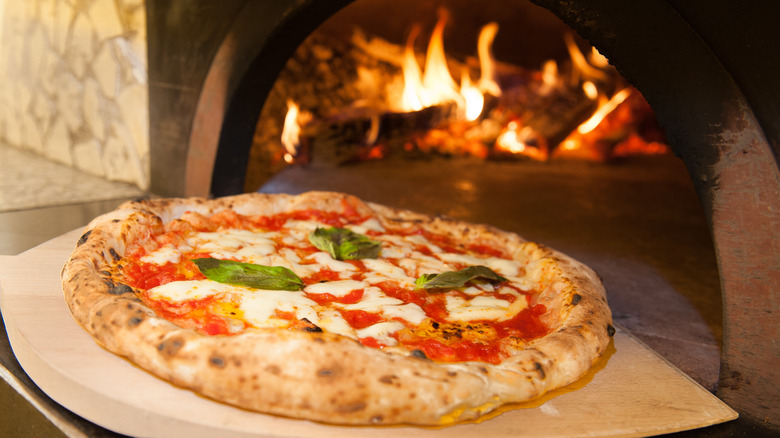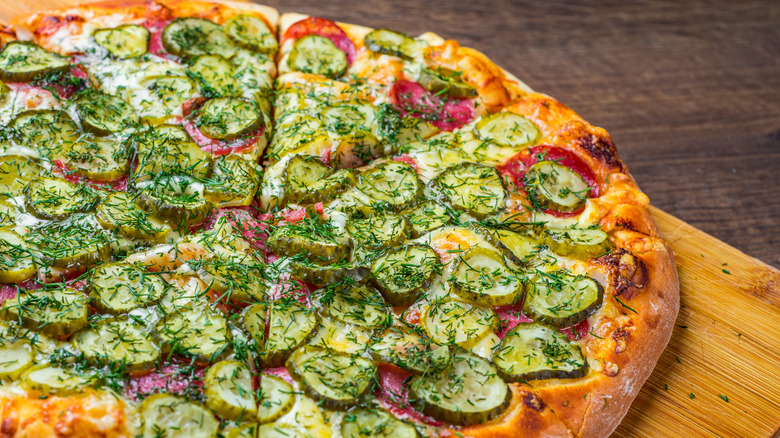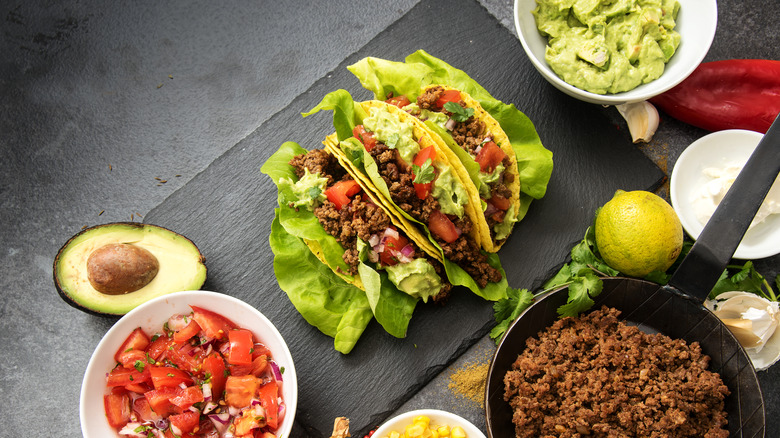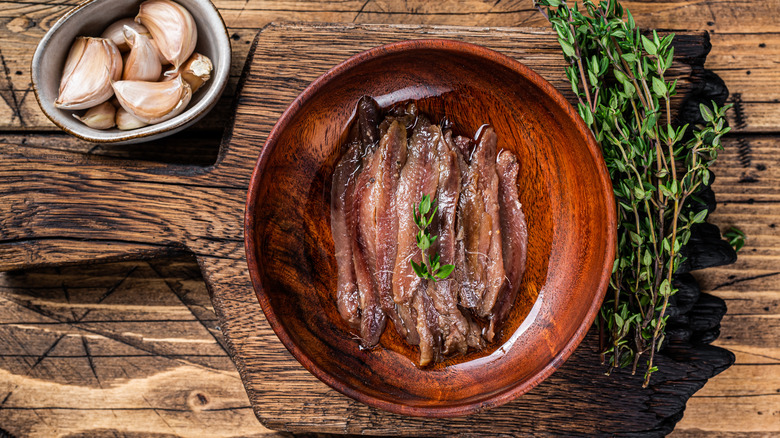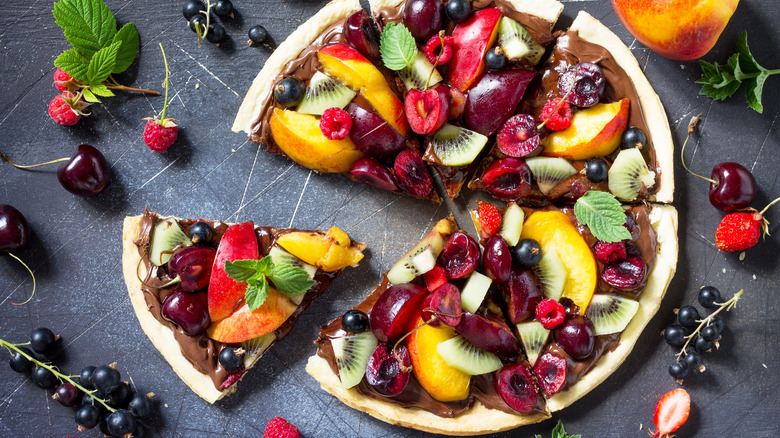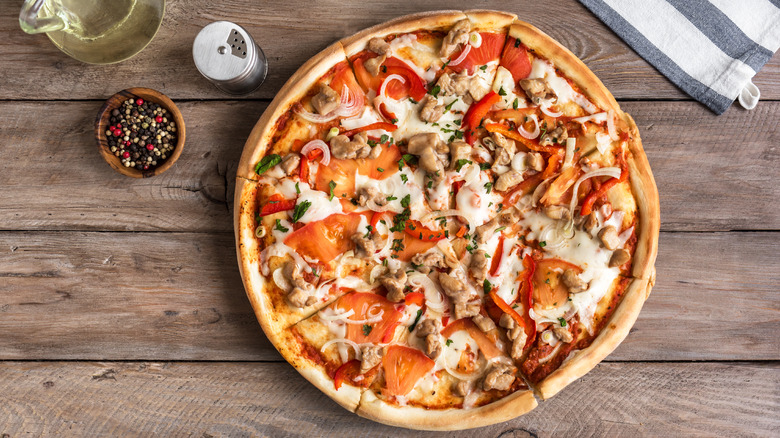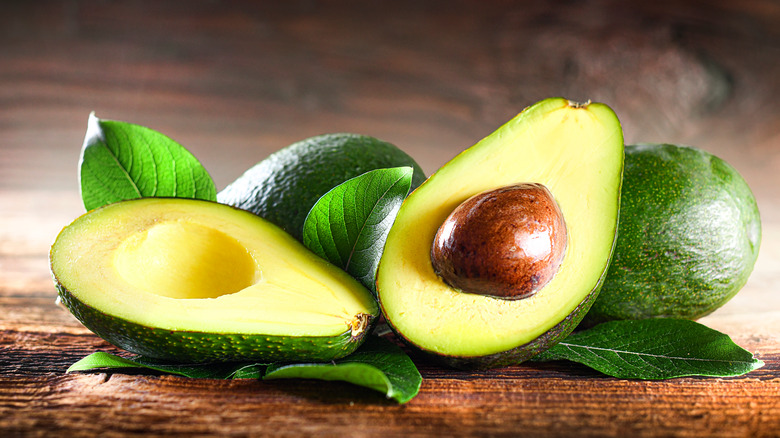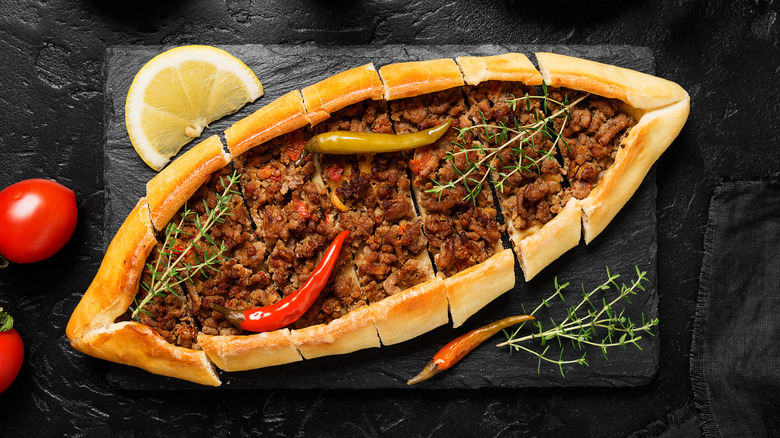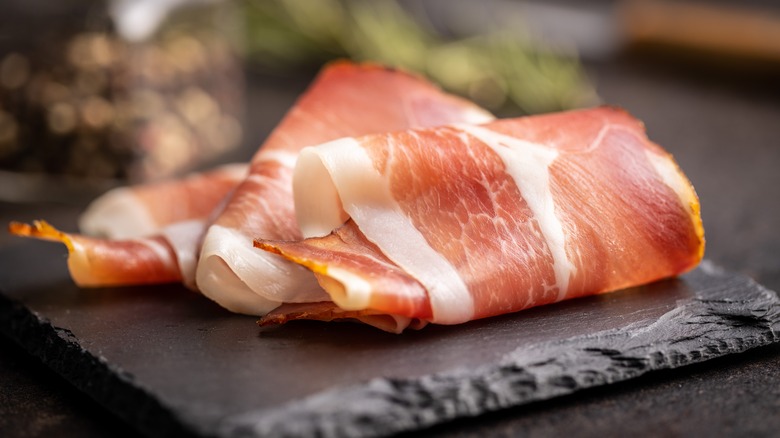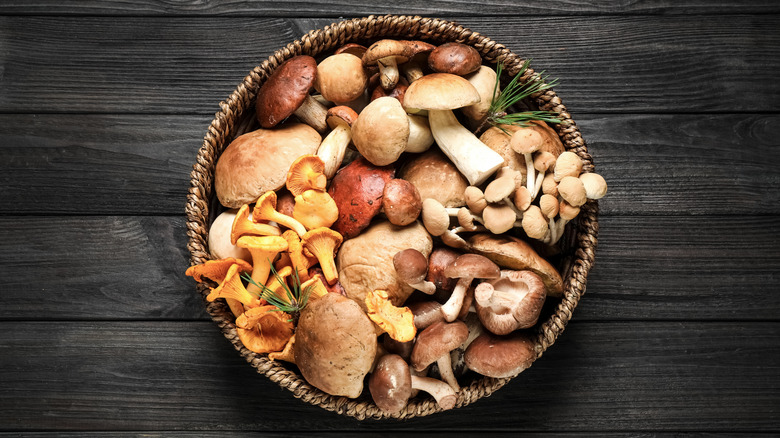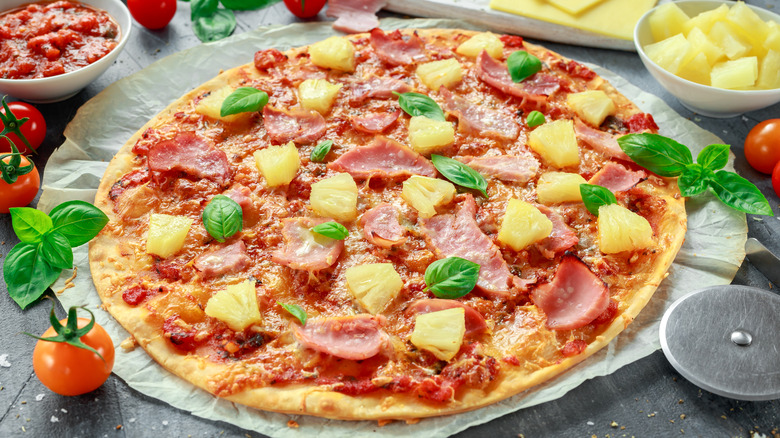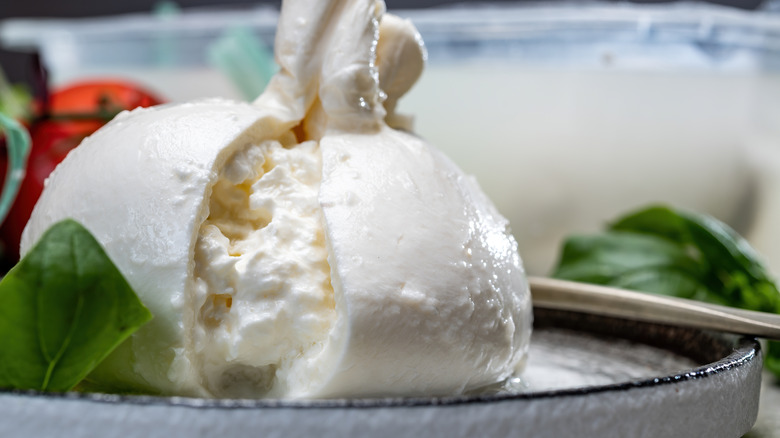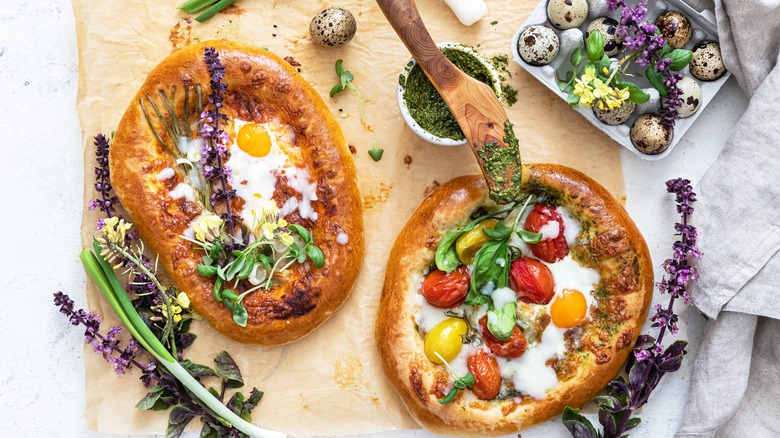The Ultimate Guide To Pizza Toppings
While baked flatbreads with toppings have a legacy dating back to ancient Greece, Rome, and Egypt, the modern-day pizza as we know it in the United States originated in the late 1700s. According to History, pizza was considered an inexpensive peasant food – the first fast food if you will – consumed by Neapolitans in the coastal city of Naples, Italy. When Queen Margherita visited the city in 1889 and was served a pie with tomatoes, fresh mozzarella, and basil, the classic Margherita pizza was born. Immigrants brought the dish to the U.S. where they adapted it to locally-available ingredients and tastes.
Regardless of whether you are a thin crust or deep dish aficionado – which is a debate that may forever divide east coasters from midwesterners – The Washington Post estimates that Americans consume about 100 acres of pizza every day. That translates to approximately 3 billion pizzas annually – or 46 slices and 23 pounds per person per year. That's an astounding amount of pizza.
But what makes the pizza so desirable? We'd argue that the reason we love it so much is that it is so incredibly versatile, and that versatility is all about the toppings. With just a touch of creativity and some ingenuity, you can top a pie with just about anything.
Dill pickle
The revelation of Rhino's Pizzeria in Rochester, New York, dill pickle pizza may sound a bit odd, but its unique combination of salty and sour actually make a lot of sense in the overarching canon of pizzadom. According to Atlas Obscura, the daughter of the owners of the pizzeria, Kathy Szuba, had just attended a dill pickle festival in 2018, when the idea came to fruition. They started with a base of white garlic sauce, topped it with thinly-sliced dill pickles, and threw on some extra dill weed to drive the flavor profile home. The result was a resounding success and became an instant hit.
While it is less common to find this pizza at other establishments, you can easily recreate the recipe yourself at home. If you want to get a taste of the authentic specimen, Rhino's pizzeria sells its signature garlic sauce on its website. Throw on some freshly grated mozzarella and thinly-sliced dill pickles, and voila! If you love the bold flavor of salt and vinegar potato chips, this pizza has your name written all over it.
Taco toppings
Anyone who lives in Illinois or Iowa is well-versed in the popularity of taco pizza. The signature creation – and best-seller – of the small-town eastern Iowa chain Happy Joe's Pizza and Ice Cream, this pizza is an exercise in the complexity of different textures in pie form. According to Bon Appetit, the layers of tomato paste, refried beans, cheese, and tomato sauce create a melty base for the ground beef and sausage, which are subsequently topped with crunchy fresh lettuce, tomatoes, and mystery-flavored, crushed tortilla chips. The result is sure to make you...well...happy.
To recreate a delectable taco pizza of your own, consider integrating flavors that are authentic to Mexican taquerias. While MasterClass notes that the options are virtually unlimited and vary depending upon the region the taco comes from, some classics include fresh cilantro, chopped onion, a squeeze of fresh lime, and a dollop of either salsa verde or salsa roja. Adding these as a garnish to the hot pizza right after it comes out of the oven can provide a brightness of flavor that elevates it to the next level.
Anchovies
The legacy of seafood on pizza is well documented. According to Slate, Italians have been donning their pies with frutti di mare for more than 2,000 years. Ancient Romans preferred a fermented fish product called garum, while further south in Naples anchovies became a staple. Not only were they cheap and abundantly available in local waters, but they also provided the perfect balance of salt and oil that complimented a classic pizza bianca.
This combination of salt and oil is a flavor that the Japanese have come to call umami. The fifth basic flavor -– in addition to sweet, sour, salty, and bitter -– umami literally translates to "deliciousness," per Vox. Its characteristic meatiness shows up in many foods ranging from mushrooms to cheese to –- you guessed it -– anchovies. What umami does better than all of the other basic flavors is to create a certain mouthfeel that lusciously coats the tongue. This unique quality is why anchovies are one of the key ingredients in the popular condiment Worcestershire sauce, according to HuffPost, and why it continues to be a popular addition to pizza.
Fruit
Who says pizza has to be savory? Dessert pizza is all the rage and we are not mad about it. What better way to get your kids to eat more fruit than to disguise it as pizza? It is a win-win situation for picky eaters and an easy way to finish off a meal. The Pioneer Woman herself, Ree Drummond, suggests starting with either a simple pizza crust base or opting for creating a crust out of a sweeter dough, like a sugar cookie or even a brownie batter.
And if you really want to get fancy, you can take the lead from some of Food Network's famous chefs by adding gourmet items like fresh goat cheese, bittersweet chocolate, and Grand Marnier. Whatever you choose, the fruit pizza takes the fun of pizza and combines it with the comfort of a fruit pie to create the perfect combination of sweet and crunchy. And don't forget, leftovers can be a great, quick breakfast option. These pizzas are chef-inspired and mom-approved.
Broccoli and the invasion of California cuisine
You know you've made the big time when you get mentioned in a Disney movie. In "Inside Out" Riley's "Anger" feeling declares, "Congratulations San Francisco, you've ruined pizza!" when she gets served a broccoli pizza. But how did California get the reputation for putting broccoli and other "healthy" vegetables on pizza? You can blame a young rebel named Alice Waters. According to the Michelin Guide, when the self-taught foodie opened her now-legendary restaurant Chez Panisse in 1971, she brought the inspiration of using fresh, locally-grown food from her travels in France to the Bay area of California. Other chefs quickly followed suit, initiating a revolution that has become affectionately known as "California cuisine."
When it comes to the pizza itself, there isn't anything particularly unique about the crust per se. The Californication of pizza lies squarely on the toppings. According to Thrillist, while California-style pizza is rooted in the traditional Neapolitan-style crust made of simple flour and water, the playfulness and creativity of combinations that chefs took chances on were what got the world's attention. Some criticize it as snobbish or over the top, but ultimately the thing that makes it distinctive is its ability to fuse something that is essentially cheap and affordable with flavors that are more quintessentially considered gourmet. It's an elegant yet relatable match made in pizza heaven.
BBQ chicken
BBQ chicken pizza may seem ubiquitous in today's culture, however, its debut occurred not so long ago at the popular restaurant empire California Pizza Kitchen. According to the Los Angeles Times, the inventor of this particular pizza, chef Ed LaDou, got his start as the first pizza chef at Wolfgang Puck's world-renowned Spago restaurant. Here, he elevated traditional pizza into a gourmet menu item with ingredients like smoked salmon and marinated shrimp. In 1985, he left Spago to open the first California Pizza Kitchen with co-founder Rick Rosenfield.
While initially, the restaurant floundered, per Fortune, the one item that was an immediate success and credited with launching the enduring legacy of the chain was the BBQ chicken pizza. Even though LaDou departed California Pizza Kitchen not long after it opened, the company has since gone on to expand its reach to include hundreds of restaurants in dozens of countries with a prosperous frozen food retail sector helmed by none other than the legendary BBQ chicken pizza.
Avocado
Move over avocado toast. Skip the chips and guac. Avocado pizza is the new best thing. The creaminess of the avocado with the crunchy pizza crust is a match made in heaven. Famed chef Jean-Georges Vongerichten developed this signature dish for his self-titled restaurant at the Waldorf Astoria in Beverly Hills. He notes that it fuses the best of ethnic culinary influences in that area, including Mexican and Asian cuisines. It also takes advantage of the fresh, locally-sourced avocado grown year-round.
And as a bonus: Avocado is a nutritional powerhouse. As noted by Medical News Today, aside from being rich in the kinds of good fat that are beneficial to cardiovascular health, they are also loaded with a wide range of vitamins and minerals, such as magnesium, potassium, lutein, and beta carotene. Additionally, they are a great source of fiber (which is necessary for digestion), as well as folate (which has been linked to the improvement of symptoms of depression). They even contain antimicrobial substances that can help build immunity to various strains of Streptococcus.
Lamb
While lamb isn't as popular a meat in the U.S., it is a staple in many cultures of North Africa and the Middle East. Not unsurprisingly, pizza-like flatbreads make an appearance in a number of countries, but perhaps the most popular iteration of this is lahmacun. According to Smithsonian Magazine, the precise origin of this dish is up for debate, with both Armenia and Turkey claiming ownership. Because meat was considered a luxury item in the ancient Middle East, this dish was prepared as a delicacy for wealthy men by their wives who cooked it over open flames during the famed caravans of the Silk Road.
Regardless of where the first lahmacun was prepared, the dish is popular today because of the complexity of flavors and the contrast in texture between the cracker-like crust and the juicy lamb. As The Week notes, the finished product is garnished with fresh herbs and lemon juice, which brings brightness and acidity to the table to round out the exotic spicy flavors of this historic culinary relic.
Prosciutto
Bacon is great on a pizza, but we prefer prosciutto on pizza thanks to its subtle flavor and unique texture. According to MasterClass, the word "prosciutto" literally translates to "ham." While prosciutto can come in two formats -– crudo or uncooked, and cotto or cooked –- the majority of prosciutto that we get in the United States is of the former variety. Prosciutto is salt-cured for at least 400 days and the finest specimens come from the region of Italy known as Parma –- hence Prosciutto di Parma.
The distinction of prosciutto as being from Parma is important. According to Web Food Culture, in 1996 the region of Parma was given the unique distinction of P.D.O. or D.O.P. which means Protected Designation of Origin. This distinction indicates a special classification of quality and historical continuity in production specific to this region, indicating the hams are more valuable and superior in flavor.
Web Food Culture goes on to highlight the unique nutritional benefits of substituting prosciutto for bacon as an ingredient. Due to its unique curing process, the meat is free of preservatives, including nitrates, nitrites, and polyphosphates. These additives, common in bacon, have been linked to an increased risk for cardiovascular disease and cancer according to WebMD. While everything in moderation is a good motto to follow when eating bacon is concerned, swapping out prosciutto makes good health sense and great flavor sense.
Mushrooms
Mushrooms on pizza are magic, but not in a psychedelic way. They are one of the most quintessential umami-filled food items on the planet and they bring this luscious, meaty flavor to a pizza in a way that can convince even that staunchest meat lover to eat a vegetarian pizza. According to The Mushroom Council, the key is using the right mushrooms to maximize the umami flavor. While all mushrooms will add umami, darker mushrooms (like shiitake, portabella, and cremini), cooked mushrooms, and dehydrated mushrooms are the richest in umami flavor.
The other primary factor in successfully incorporating mushrooms into your pizza game is knowing how to properly prepare and cook for maximum flavor and texture. Some of the most common mistakes when preparing mushrooms include washing them, not cooking them at a high enough temperature, not using enough fat to cook them in, crowding the mushrooms too tightly into the pan, and cutting them too thin. Texture tends to be one of the things people dislike most frequently about mushrooms and every single one of these mistakes can increase the squishiness that makes them unappealing. For this reason, we recommend using fresh mushrooms and cooking them yourself rather than opting for canned mushrooms.
Hawaiian toppings and the great pineapple debate
No discussion about pizza toppings would be complete without weighing in on the great pineapple debate. Ironically, this pizza did not originate in Hawaii, despite its moniker. According to Time, it was invented by restaurateur Sam Panopoulos, a Greek immigrant who owned an establishment in Ontario, Canada. In 1962, he got the idea in his head that the sweetness of pineapple might compliment the saltiness of ham on a pizza and decided to try it. The result became an instant cult classic and he named it the Hawaiian after the specific brand of canned pineapple he used.
While the combination quickly spread across the globe, so did the controversy about whether or not pineapple belongs on pizza. As the BBC notes, the president of Iceland Gudni Thorlacius Johannesson famously dissed the pie and threatened to ban it in the country. This sparked a fun-loving spar with Canadian prime minister Justin Trudeau. While some surmise that the reason it offends is because the high acidity of the pineapple mixed with that of the tomato sauce can be difficult to digest, others insist that the sweet-savory pairing is perfect. Ultimately it's a personal decision, but we are fans. For a little balance between the pineapple and the ham, try adding some mushrooms. You'll thank us.
Fresh mozzarella
Sure, grated mozzarella is a staple of most pizza because it melts so well, but have you tried fresh mozzarella on top of your pizza instead? According to Grapes and Grains, fresh mozzarella – or buffalo mozzarella – originated in the 12th century at a monastery in Capua, a town in the region of southern Italy known as Campania. In the 13th century, buffalo's milk began to be used as a cheaper alternative and a legend was born. The cheese gets its name from the term "mozzare" which translates to "to cut off," referencing the process by which the balls of cheese are cut off after the curds have been superheated and melted together into a creamy consistency.
While mozzarella is now often made of cow's milk, small batches of the buffalo varietal can still be found in Campania, which is protected under the P.D.O. Fresh mozzarella can be purchased in most grocery stores, as can its cousin burrata, which is fresh mozzarella filled with cream. However, if you are feeling adventurous it is actually pretty easy to make at home. According to New England Cheese Making Supply Co., all that is required is rennet, citric acid, milk, salt, and a good thermometer. In about 30 minutes you can have luscious, fresh, homemade mozzarella that you can slice and add straight onto your favorite pizza.
Eggs
Pizza for breakfast? Yes, please. How many of us have eaten cold pizza for breakfast? Experts at Prevention say that when done correctly, it may be a healthier option than sugary cereals. The key is to incorporate foods that are high in protein and fiber as well as rich in nutrients. That's where the egg comes in. According to WebMD, eggs are a complete protein and are loaded with not only vitamins and minerals that are necessary for overall health, but with the kind of good cholesterol that can be beneficial in terms of cardiovascular health.
Health benefits aside, we agree with Southern Living magazine that adding an egg to a pizza is the perfect compliment to an already pretty perfect food. The creaminess of a runny egg can balance out the acidity of the tomato sauce, and dipping a piece of crust into that cheese-like egg yolk is transcendental.
The key is cooking it correctly, which means just long enough to cook the whites through while leaving the yolk runny. This may take some experimentation to get it right, but it helps to use room-temperature eggs. And don't forget to season the eggs once they come out of the oven. A little dash of salt and pepper and perhaps some fresh basil or greens will take your pizza game to the next level.
Edible flowers
The culinary use of flowers is not novel in spite of its seeming resurgence in fine dining establishments. According to What's Cooking America, cultures ranging from ancient Rome to China to the kitchen of Queen Victoria have been including edible flowers in their creations for centuries. Popular for their look, flavor, and even their nutritional value, the art of using flowers in cooking is a subtle one that requires an understanding of not only what is safe to consume, but how to prepare the plants and ultimately cook with them. It's important to use flowers that have not been sprayed with pesticides or herbicides, and that have been cultivated for culinary purposes (unless you are working with someone skilled in foraging wild varietals).
Emerald Coast Magazine suggests that edible flowers are best applied as toppings on pizza in their raw form as a garnish, where their freshness and color can truly be appreciated. Favorites include flowers that taste like the plants they come from, such as chives, fennel, basil, rosemary, and thyme. Additional specimens of note are nasturtium, marigold, and calendula, which all have a peppery bite uniquely suited for use on a pizza.
One exception to the use of edible flowers as a garnish are squash blossoms, which are quite common in Italian cuisine. The subtly sweet flavor pairs beautifully when combined with fresh herbs and mild cheeses like ricotta. After the blossoms bake they become crispy and deliver a delightful contrast to the melted unctuous cheese.
